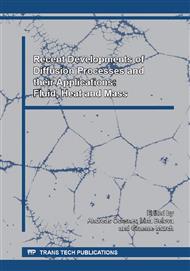p.122
p.132
p.139
p.147
p.157
p.165
p.174
p.182
p.192
Effect of Ultrasonic Nanocrytalline Surface Modification on Hardness and Microstructural Evolution of Cu-Sn Alloy
Abstract:
In this study, a Cu-Sn sintered bronze, used largely for con-rod bushing and automotive transmission, was treated by ultrasonic nanocrystalline surface modification (UNSM). Then, Vickers hardness and microstructural evolution of the treated region were investigated by using scanning electron microscope (SEM), X-ray diffraction (XRD) and transmission electron microscope (TEM). The hardness of the treated surface doubled, which is attributed to the developed of nanoscale grains, deformation twins, and high density of dislocations induced by the UNSM. Microstructural modification beneath the UNSM treated surface was typically characterized with increase of the depth: (i) nanoscale grains (top surface), (ii) intersection of deformation twins (~30 μm), (iii) high density nanoscale twin/matrix lamellae (~50 μm), (iv) interception of micro band and deformation twins (~100 μm), (v) dislocation arrays (~200 μm), (vi) low density dislocations (~300 μm) and (vii) pre-existing coarse grains and annealing twins in unaffected region (400 μm ~deeper).
Info:
Periodical:
Pages:
157-164
Citation:
Online since:
June 2015
Authors:
Keywords:
Price:
Сopyright:
© 2015 Trans Tech Publications Ltd. All Rights Reserved
Share:
Citation:


